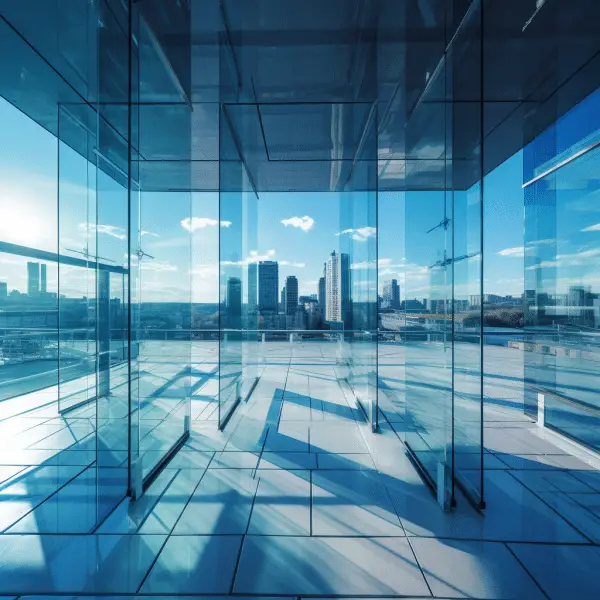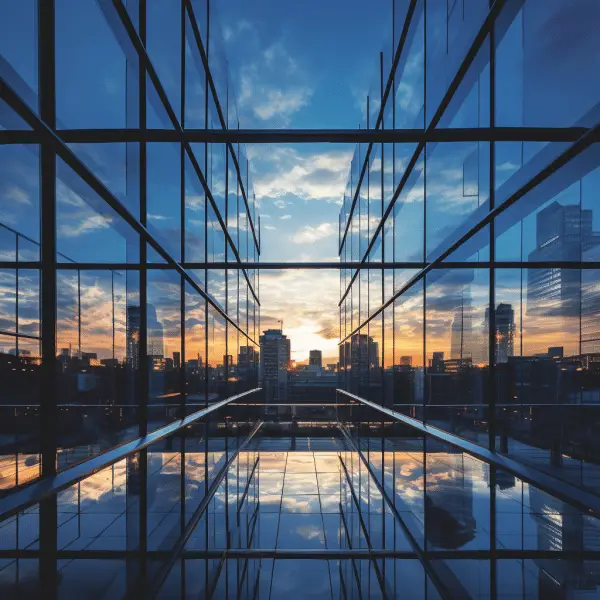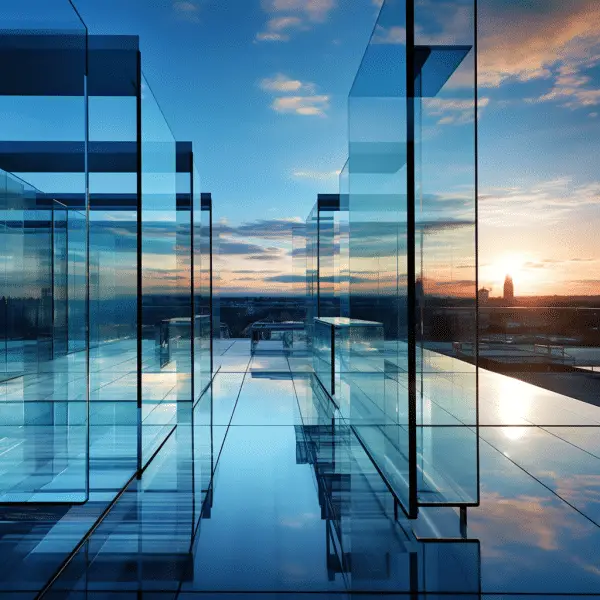The Evolution and Versatility of Glass in Construction
Glass has become an integral part of the construction industry, offering a wide range of benefits and applications. Glass in construction has changed architectural design by improving aesthetics, insulation, and energy efficiency. The adaptable and transparent material glass has become ubiquitous in construction, creating modern architecture and driving trends.
Key Takeaways:
- Glass plays a crucial role in modern building construction, providing aesthetic value, insulation, privacy, and energy efficiency.
- There are different types of glass used in construction, each with its unique properties and advantages.
- Glass has a rich history in architecture, dating back centuries, and has evolved with advancements in glass manufacturing technology.
- Incorporating glass into construction offers numerous advantages, including transparency, durability, and recyclability.
- While glass has many advantages, there are also some considerations such as its brittleness and the need for regular cleaning in certain environments.
The History of Glass in Construction
Glass’s construction history is amazing. It has been utilized for ages to improve building functioning and aesthetics. Glass has grown from vessels and tiles to be a versatile and sought-after building element.
Glass was widely used as a decorative element in structures once Europe invented glass blowing in the 1st century. Cast glass windows found in Roman ruins demonstrate early glass production. Churches used colored glass in the 17th century to brighten stained glass windows.
The 1958 creation of float glass was a major milestone in glass building. The new manufacturing method produced distortion-free glass sheets. Glass became a wall structural feature, adding transparency and modernity.
The history of glass in construction influences architecture today. Through ancient cast glass windows to modern clear glass design, glass has evolved with our connection with materials and technology.
“Glass has been a transformative material in the construction industry, allowing architects to push the boundaries of design and create structures that embody transparency, elegance, and sustainability.” – Glass Architectural Historian

Types of Glass Used in Construction
When it comes to construction, different types of glass are utilized for their unique properties and advantages. Each type serves a specific purpose, contributing to the overall functionality and aesthetic appeal of a building. Here are some of the commonly used glass types in construction:
- Sheet or Flat Glass: This is a cost-effective option with a flat finish, often used for windows and simple glazing.
- Float Glass: Also known as soda-lime glass, it is made by floating molten glass on molten tin to create a clear, flat surface. Float glass is widely used in windows, doors, and facades.
- Laminated Glass: Consisting of multiple layers of glass bonded with a polymer, laminated glass offers safety and acoustic insulation. It is commonly used in areas where impact resistance is required.
- Energy-Efficient Glass: Glazed with a special coating, energy-efficient glass reduces thermal energy transfer, making buildings more energy-efficient and environmentally friendly.
fire-rated doors and windows
- Wired Glass: Embedded with a metal mesh, wired glass provides added strength and safety during fires. It is often used in fire-rated doors and windows.
- Tinted Glass: Tinted glass offers both aesthetic and practical benefits. It adds color to a building’s exterior while reducing heat gain from sunlight.
- Tempered Glass: This type of glass is strengthened through a heating and cooling process, making it stronger and safer than regular glass. It breaks into small, granular pieces upon impact, reducing the risk of injury.
- Patterned Glass: With various designs and textures, patterned glass adds privacy and decorative elements to a building’s interior and exterior.
- Glass Blocks: These translucent bricks allow light to pass through while providing privacy and partitioning spaces.
These different types of glass offer architects and designers a wide range of options to suit their specific construction needs, whether it’s for safety, insulation, energy efficiency, or aesthetics.
| Glass Type | Properties | Applications |
|---|---|---|
| Sheet or Flat Glass | Low-cost, flat finish | Windows, simple glazing |
| Float Glass | Clear, flat surface | Windows, doors, facades |
| Laminated Glass | Safety, acoustic insulation | Areas requiring impact resistance |
| Energy-Efficient Glass | Reduced thermal energy transfer | Energy-efficient buildings |
| Wired Glass | Added strength, safety during fires | Fire-rated doors, windows |
| Tinted Glass | Color, reduced heat gain | Building exteriors |
| Tempered Glass | Strength, safety | Windows, glass partitions |
| Patterned Glass | Privacy, decorative elements | Interior, exterior design |
| Glass Blocks | Translucent, privacy | Partition walls, light diffusion |
Advantages of Using Glass in Construction
Glass is a versatile material that offers numerous advantages when used in construction. Its transparent nature allows natural light to penetrate buildings, reducing the need for artificial lighting and creating a bright and inviting atmosphere. This not only enhances the aesthetic appeal of a structure but also has the potential to improve the well-being of its occupants. The use of glass in architectural design is a current trend that reflects the desire for open and light-filled spaces.
In addition to its transparency, glass also provides insulation properties, acting as an electrical insulator and helping to reduce energy costs. By effectively retaining heat, glass can contribute to maintaining comfortable indoor temperatures, especially when combined with energy-efficient glazing techniques. This can lead to significant energy savings in the long term and a reduced environmental impact.
Glass is also a durable material that is easy to maintain. It is resistant to corrosion, scratches, and chemical damage, making it suitable for various applications in both interior and exterior settings. Regular cleaning with a basic glass cleaner is usually sufficient to keep glass surfaces looking pristine. Furthermore, glass is 100% recyclable, making it an environmentally friendly choice for construction projects that aim to minimize waste and promote sustainability.
| Advantages of Using Glass in Construction |
|---|
| Transparency and natural light |
| Insulation properties and energy efficiency |
| Durable and easy to maintain |
| Environmentally friendly and recyclable |
Disadvantages of Using Glass in Construction
While glass offers numerous advantages in construction, it also comes with a few disadvantages that need to be considered. One of the first drawbacks is the energy consumption during the manufacturing process. Glass manufacturing requires high temperatures and significant energy inputs, which can contribute to environmental concerns.
An inherent characteristic of glass is its brittleness. When subjected to substantial stress or impact, glass can break, leading to potential safety hazards. Broken glass fragments can be sharp and pose a risk of injury, making it important to handle and install glass panels with care.
Furthermore, glass surfaces may require regular cleaning, especially in dusty or humid environments. Dust particles and moisture can accumulate on the glass, affecting its transparency and aesthetics. Regular cleaning and maintenance are necessary to ensure that the glass remains clear and visually appealing.
Summary:
- Glass manufacturing can be energy-consuming.
- Glass is inherently brittle and can break under stress.
- Glass surfaces may require regular cleaning in dusty and humid environments.
Table: Disadvantages of Using Glass in Construction
| Disadvantages | Description |
|---|---|
| Energy Consumption | High energy consumption during the manufacturing process. |
| Brittleness | Glass is prone to breakage under substantial stress or impact. |
| Regular Cleaning Needed | Glass surfaces require regular cleaning, particularly in dusty or humid environments. |
Future Developments in Glass Architecture
As technology continues to advance, the future of glass in architecture holds exciting possibilities. Architects and engineers are constantly exploring innovative ways to enhance the performance and sustainability of glass in construction. One area of development is the integration of smart glass, which can dynamically adjust its transparency to regulate light and heat. This technology not only improves energy efficiency but also offers greater control over privacy and glare reduction.
Another promising avenue is the use of self-cleaning glass, which incorporates special coatings that repel dirt and water, reducing the need for frequent cleaning and maintenance. This not only saves time and resources but also improves the longevity of glass structures. Additionally, the incorporation of nanotechnology in glass manufacturing is expected to enhance its strength and durability, making it more resistant to breakage and impacts.
In terms of sustainability, researchers are exploring the concept of energy-generating glass. By integrating photovoltaic cells into the glass panels, buildings can generate their own electricity by harnessing solar energy. This not only reduces reliance on traditional power sources but also contributes to a more sustainable and eco-friendly approach to architecture. Furthermore, advancements in glass recycling technology are enabling the production of high-quality recycled glass, reducing the environmental impact of glass manufacturing.
In summary, the future of glass in architecture is characterized by constant innovation and a focus on sustainability. With the development of smart glass, self-cleaning capabilities, and energy-generating properties, glass will continue to play a significant role in creating environmentally friendly and visually stunning structures. As technology progresses, architects will have even more tools at their disposal to push the boundaries of what glass can achieve in construction.
Innovations in Glass Architecture
As glass architecture continues to evolve, architects and designers are exploring new innovations to push the boundaries of what is possible. Here are some of the latest developments in glass technology:
- Dynamic glass: Glass that can change its transparency at the touch of a button, offering enhanced privacy and glare reduction.
- Self-healing glass: Glass that has the ability to repair itself from scratches and minor damages, reducing the need for replacements.
- Interactive glass: Glass that can display digital content, turning windows and walls into interactive screens.
- Biodegradable glass: Glass that is made from environmentally friendly materials and can decompose naturally over time.
- Augmented reality glass: Glass that integrates augmented reality technology, allowing users to interact with virtual objects in the real world.
These innovations not only enhance the functionality of glass in construction but also open up new possibilities for creative and visually stunning architectural designs.
Table: Future Developments in Glass Architecture
| Innovation | Description |
|---|---|
| Smart glass | Glass that can dynamically adjust its transparency, improving energy efficiency and privacy control. |
| Self-cleaning glass | Glass with special coatings that repel dirt and water, reducing the need for cleaning and maintenance. |
| Energy-generating glass | Glass panels integrated with photovoltaic cells to generate electricity from solar energy. |
| Nanotechnology in glass | The use of nanotechnology to enhance the strength and durability of glass, making it more resistant to breakage and impacts. |
| Glass recycling technology | Advancements in glass recycling to produce high-quality recycled glass, reducing the environmental impact of manufacturing. |
Clear Glass in Contemporary Architecture
Clear glass is a prominent feature in contemporary architecture, serving as a versatile and visually appealing material. Its exceptional optical clarity allows natural light to flow into buildings without distortion or coloration, creating bright and open spaces. This transparency enhances the overall aesthetic appeal of the structure, making it a popular choice among architects and designers.
In addition to its aesthetic qualities, clear glass offers practical benefits in architectural design. As an energy-efficient material, it reduces the need for artificial lighting and helps to regulate the indoor climate. The abundant natural light that clear glass allows also contributes to a more comfortable and pleasant environment for building occupants.
Clear glass finds application in various architectural elements, including windows, doors, skylights, façades, dividers, stairs, and balustrades. Its durability and resistance to chemical deterioration, scratches, and abrasions make it a reliable choice for these applications. Clear glass is not only aesthetically pleasing but also long-lasting, ensuring that buildings maintain their elegance and sophistication over time.
| Applications of Clear Glass in Contemporary Architecture | Advantages |
|---|---|
| Windows | Enhances natural light, provides unobstructed views |
| Doors | Creates a visually inviting entrance, promotes transparency |
| Skylights | Brings in abundant natural light, improves indoor atmosphere |
| Façades | Creates a modern and sleek exterior, adds architectural interest |
| Dividers | Separates spaces while maintaining visual connectivity |
| Stairs and Balustrades | Provides safety and elegance through transparent design |
As contemporary architecture continues to evolve, the use of clear glass remains a fundamental element. Its unique properties and advantages contribute to the creation of functional and visually stunning structures. Clear glass provides architects and designers with the opportunity to merge form and function, resulting in buildings that are both visually striking and efficient in their use of natural resources.
Advantages and Benefits of Clear Glass in Construction
Clear glass, as a versatile and visually appealing material, offers numerous advantages in construction. Its use in architectural design brings several benefits that contribute to the overall functionality and aesthetic appeal of a building.
“Clear glass allows natural light to penetrate the structure, creating a bright and inviting environment. This reduces the need for artificial lighting and helps improve the indoor climate, resulting in energy savings and a more comfortable space.”
One of the key advantages of clear glass is its ease of maintenance. With a basic glass cleaner, it can be effortlessly cleaned, ensuring a pristine and attractive appearance. Additionally, clear glass is 100% recyclable, making it an environmentally friendly choice for sustainable construction practices.
Clear glass also adds a modern and contemporary touch to a building’s design. Its transparency and sleek appearance enhance the aesthetic appeal, creating a visually striking structure. Architects and designers often incorporate clear glass to create an open and airy atmosphere, allowing for unobstructed views and a connection with the surroundings.
| Advantages of Clear Glass in Construction | Benefits |
|---|---|
| Allows natural light penetration | – Reduces need for artificial lighting |
| Easy to clean | – Maintains pristine appearance |
| 100% recyclable | – Supports sustainable construction practices |
| Enhances building aesthetics | – Creates a modern and contemporary design |
Overall, the use of clear glass in construction offers architects and designers the opportunity to create buildings that are not only functional but also visually stunning. With its benefits of natural light penetration, easy maintenance, recyclability, and aesthetic appeal, clear glass continues to be a popular choice in the world of architecture.

Conclusion
In conclusion, the use of glass in construction is a significant aspect of modern architectural design. Glass offers a range of advantages, including aesthetic appeal, insulation, and energy efficiency. It has a rich history and has evolved over time to meet the changing needs of the construction industry.
With various types of glass available, such as tempered, laminated, and tinted glass, architects have the flexibility to choose the most suitable option based on their unique requirements. Glass provides transparency and allows natural light to penetrate buildings, creating a pleasant and inviting environment while reducing the need for artificial lighting. Its durability, easy maintenance, and recyclability contribute to sustainable construction practices.
The future of glass in construction looks promising, with advancements in technology and a growing emphasis on sustainable architecture. Clear glass, in particular, has become a staple in contemporary design, offering exceptional optical clarity, energy efficiency, and resistance to deterioration. As architectural trends continue to evolve, glass will remain a crucial element in creating functional and visually appealing structures.
By incorporating glass into their designs, architects and builders can create buildings that are not only aesthetically pleasing but also sustainable and energy-efficient, contributing to a better future for the construction industry and the environment.
FAQ
What are the different types of glass used in construction?
The different types of glass used in construction include tempered glass, float glass, tinted glass, laminated glass, reflective glass, patterned glass, wired glass, and insulated glass.
What are the advantages of using glass in construction?
Glass offers transparency, natural light penetration, aesthetic appeal, insulation, durability, and energy efficiency, making it a valuable material in construction.
Are there any disadvantages to using glass in construction?
Some disadvantages of using glass in construction include its energy-intensive manufacturing process, brittleness, and the need for regular cleaning in specific environments.
What is the history of glass in construction?
Glass has been used in construction for centuries, starting with glass vessels and tiles. It evolved to become a decorative element in buildings, with the development of glass blowing and the float glass process revolutionizing glass manufacturing.
How is clear glass used in contemporary architecture?
Clear glass is used in contemporary architecture for windows, doors, skylights, façades, dividers, stairs, and balustrades. It adds elegance and sophistication to any space, with its exceptional optical clarity and energy efficiency.
What are the future developments in glass architecture?
The future of glass in construction includes advancements in technology and sustainability, such as the use of clear glass for solar panels and the development of more energy-efficient, durable, and safe glass materials.
Source Links
- https://theconstructor.org/building/building-material/exploring-the-different-types-of-glass-used-in-construction/570636/?amp=1
- https://mtcopeland.com/blog/how-is-glass-used-for-construction/
- https://medium.com/@saintgobainglasses/from-function-to-elegance-exploring-the-applications-of-clear-glass-in-contemporary-buildings-464039e1750e








